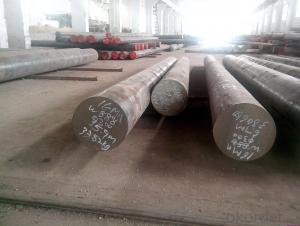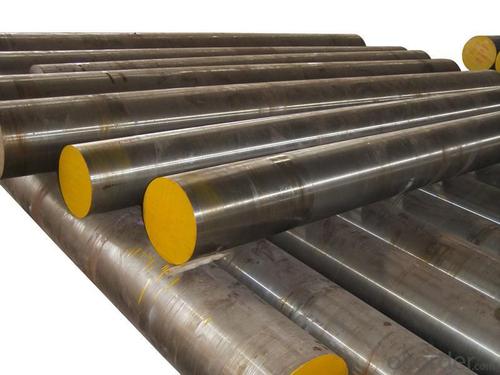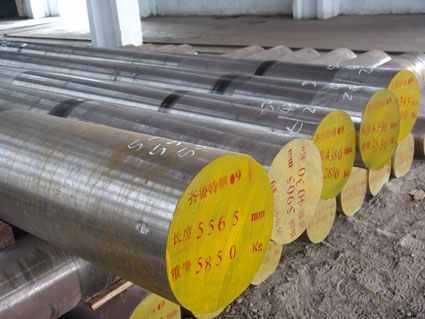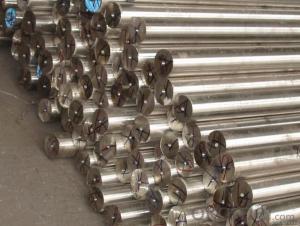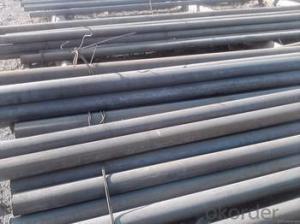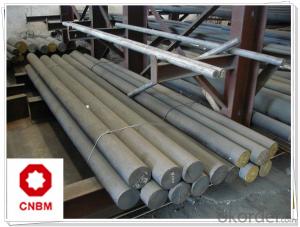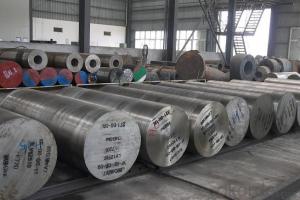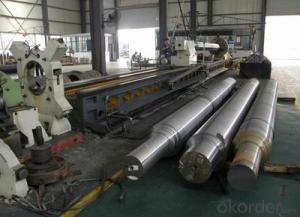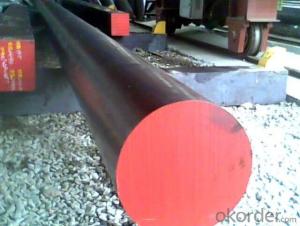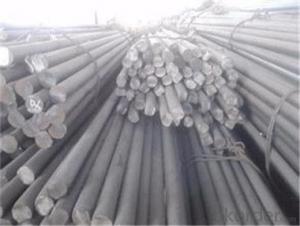45# China Standard Forged Steel Round Bar
- Loading Port:
- Shanghai
- Payment Terms:
- TT or LC
- Min Order Qty:
- 25 m.t.
- Supply Capability:
- 10000 m.t./month
OKorder Service Pledge
OKorder Financial Service
You Might Also Like
Product Description:
OKorder is offering Round Bar at great prices with worldwide shipping. Our supplier is a world-class manufacturer of steel, with our products utilized the world over. OKorder annually supplies products to European, North American and Asian markets. We provide quotations within 24 hours of receiving an inquiry and guarantee competitive prices.
Product Applications:
1) Suitable for making various strong cutting tool abrasion resistance, impact resistance.
2) Used to produce all kinds of high hard and super hard saw blade, drill, tap, broach, gear hob and various kinds of milling cutter.
3) Used for advanced punching die, screw die, and the toughness and complicated shape of the punch, etc.
Product Advantages:
OKorder's Round Bar are durable, strong, and resist corrosion.
Main Product Features:
· Premium quality
· Prompt delivery & seaworthy packing (30 days after receiving deposit)
· Corrosion resistance
· Can be recycled and reused
· Mill test certification
· Professional Service
· Competitive pricing
Product Specifications:
Diameter | Mass | Diameter | Mass | Diameter | Mass |
(mm) | (kg/m) | (mm) | (kg/m) | (mm) | (kg/m) |
6 | 0.22 | 22 | 2.98 | 53 | 17.30 |
7 | 0.30 | 24 | 3.55 | 56 | 19.30 |
8 | 0.40 | 25 | 3.85 | 60 | 22.20 |
9 | 0.50 | 26 | 4.17 | 63 | 24.50 |
10 | 0.62 | 28 | 4.83 | 65 | 26.00 |
11 | 0.75 | 30 | 5.55 | 70 | 30.20 |
12 | 0.89 | 32 | 6.31 | 75 | 34.70 |
13 | 1.04 | 34 | 7.13 | 80 | 39.50 |
14 | 1.21 | 36 | 7.99 | 85 | 44.50 |
15 | 1.39 | 38 | 8.90 | 90 | 49.90 |
16 | 1.58 | 40 | 9.86 | 95 | 55.60 |
17 | 1.78 | 42 | 10.90 | 100 | 61.70 |
18 | 2.00 | 45 | 12.50 | 120 | 88.85 |
19 | 2.23 | 48 | 14.20 | 140 | 120.93 |
20 | 2.47 | 50 | 15.40 | 150 | 138.82 |
Material: Mild Steel
Heat treatment of high quality steel:
Fire: Isothermal annealing temperature is 800 ~ 880 °C, with 10 ~ 20 °C, the furnace cooling to about 600 °C, hardness above HB269.
Preheat temperature: 730-730 °C
Quenching temperature: 1190-1210 °C
Tempering temperature: 540-595 °C
Cold drawn, hardness 285 HBS
Cold drawn after annealing condition, hardness 277 HBS
Quenching methods: oil quenching, air cooling or salt bath quenching
FAQ:
Q1: Why buy Materials & Equipment from OKorder.com?
A1: All products offered byOKorder.com are carefully selected from China's most reliable manufacturing enterprises. Through its ISO certifications, OKorder.com adheres to the highest standards and a commitment to supply chain safety and customer satisfaction.
Q2: How do we guarantee the quality of our products?
A2: We have established an advanced quality management system which conducts strict quality tests at every step, from raw materials to the final product. At the same time, we provide extensive follow-up service assurances as required.
Q3: How soon can we receive the product after purchase?
A3: Within three days of placing an order, we will begin production. The specific shipping date is dependent upon international and government factors, but is typically 7 to 10 workdays.
Images:

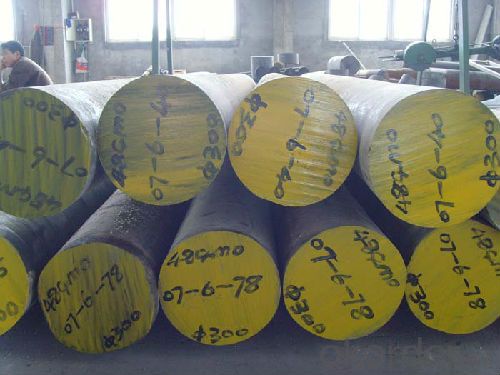
- Q: Can steel round bars be used in the manufacturing of conveyor systems?
- Yes, steel round bars can be used in the manufacturing of conveyor systems. Steel is a strong and durable material that can withstand heavy loads and provide stability and support to conveyor systems. Steel round bars can be used as rollers or shafts in conveyor systems to facilitate the movement of materials or products along the conveyor belt. The smooth surface of the round bars allows for easy rotation and reduces friction, ensuring the smooth operation of the conveyor system. Additionally, steel round bars can be easily customized to fit specific conveyor system requirements, making them versatile and suitable for various industrial applications.
- Q: How do you calculate the weight of a steel round bar based on its volume and density?
- To calculate the weight of a steel round bar based on its volume and density, you can use the formula: Weight = Volume x Density First, determine the volume of the round bar. The volume of a cylinder, which is the shape of a round bar, can be calculated using the formula: Volume = π x (diameter/2)^2 x length Where π is a mathematical constant approximately equal to 3.14159, and the diameter and length are measurements of the round bar. Once you have the volume, you need to know the density of the steel. The density of steel can vary depending on the type and grade of steel being used. The density is usually measured in kilograms per cubic meter (kg/m^3) or pounds per cubic inch (lbs/in^3). You can find the density of steel in reference materials or online. Finally, multiply the volume by the density to obtain the weight of the steel round bar. Make sure the units of volume and density are consistent. For example, if the volume is in cubic inches and the density is in pounds per cubic inch, the weight will be in pounds. If the volume is in cubic meters and the density is in kilograms per cubic meter, the weight will be in kilograms. It is important to note that this calculation assumes the round bar is made entirely of steel and has a uniform density throughout its volume. Additionally, this calculation does not consider any other factors that may affect the weight, such as impurities or surface finish.
- Q: Are steel round bars suitable for decorative purposes?
- Yes, steel round bars can be suitable for decorative purposes. Steel is a versatile and durable material that can be shaped and manipulated into various designs and patterns. Steel round bars can be used to create decorative elements such as railings, furniture, sculptures, and architectural details. The smooth and shiny surface of steel can add a modern and sleek aesthetic to any space. Additionally, steel is known for its strength and longevity, making it a practical choice for decorative purposes as it can withstand environmental factors and maintain its appearance over time.
- Q: What is the difference between a seamless and a precision ground steel round bar?
- A solid cylindrical steel billet is heated and pierced to create a hollow tube-like structure, resulting in a seamless steel round bar. This manufacturing method guarantees a uniform outer diameter throughout the entire length of the bar, making it ideal for applications that necessitate a smooth surface finish and high dimensional accuracy. Industries such as oil and gas, automotive, and aerospace commonly employ seamless round bars. On the contrary, a precision ground steel round bar is produced by subjecting a hot-rolled or cold-drawn steel bar to precise grinding processes. These processes eliminate any surface imperfections, achieve meticulous dimensional tolerances, and provide a polished and smooth finish. Precision ground round bars are typically utilized in applications that require strict tolerances, superior surface finish, and consistent dimensions, such as in the production of machinery parts, tools, and components. In conclusion, the primary distinction between a seamless and a precision ground steel round bar lies in the manufacturing process and the resulting characteristics. Seamless round bars are formed from a hollow tube-like structure, ensuring a consistent outer diameter, whereas precision ground round bars are created by grinding a solid steel bar to achieve tight tolerances and exceptional surface finish. Both types of round bars offer their own advantages and find application in various industries based on specific requirements.
- Q: Can steel round bars be used in the production of couplings?
- Yes, steel round bars can be used in the production of couplings. Steel round bars provide strength, durability, and stability, making them suitable for use in various applications, including couplings.
- Q: Can steel round bars be used in the manufacturing of bearings?
- Typically, steel round bars are not utilized in the production of bearings. Bearings necessitate materials with distinct qualities, such as exceptional strength, hardness, and resistance to wear. Steel round bars may not possess these attributes to the necessary extent. Instead, bearings are usually crafted from top-notch steel alloys that are specifically engineered for bearing purposes, such as bearing steel or stainless steel. These materials undergo specialized heat treatment procedures to attain the desired properties essential for bearing manufacturing, including the ability to bear heavy loads, minimal friction, and long-lasting endurance.
- Q: Are steel round bars resistant to impact?
- In general, steel round bars exhibit resistance against impacts. Steel is renowned for its remarkable strength and durability, rendering it highly impervious to forces and impacts. Additionally, the circular configuration of these bars aids in evenly dispersing the impact, thereby diminishing the likelihood of deformation or fracture. Nevertheless, it is crucial to acknowledge that the steel's resistance to impact may vary depending on the grade and quality, as well as the magnitude and characteristics of the impact force.
- Q: How are steel round bars measured?
- Steel round bars are measured by their diameter, which is typically specified in millimeters or inches. The measurement is taken by using a caliper or a micrometer at various points along the bar, ensuring accuracy and consistency.
- Q: Can steel round bars be used for making interior components?
- Yes, steel round bars can be used for making interior components. Steel is a durable and versatile material that can be shaped and formed into various designs and structures. Round bars are particularly suitable for creating interior components such as handrails, staircases, furniture frames, and decorative elements. They provide strength, stability, and an aesthetic appeal to interior spaces. Additionally, steel round bars can be easily welded, bent, or cut to meet specific design requirements, making them an ideal choice for custom-made interior components.
- Q: What is the typical yield strength of a steel round bar?
- The typical yield strength of a steel round bar can vary depending on the specific grade of steel used. However, for most common grades of steel, the yield strength typically falls within the range of 36,000 to 80,000 pounds per square inch (psi). It is important to note that this range is a general guideline, and there are exceptions and variations among different grades of steel. Additionally, factors such as the manufacturing process and any additional treatments or heat treatments applied to the steel can also impact its yield strength. Therefore, it is always advisable to consult the specific material specifications or consult with a metallurgical expert for accurate and precise information regarding the yield strength of a particular steel round bar.
Send your message to us
45# China Standard Forged Steel Round Bar
- Loading Port:
- Shanghai
- Payment Terms:
- TT or LC
- Min Order Qty:
- 25 m.t.
- Supply Capability:
- 10000 m.t./month
OKorder Service Pledge
OKorder Financial Service
Similar products
Hot products
Hot Searches
Related keywords

